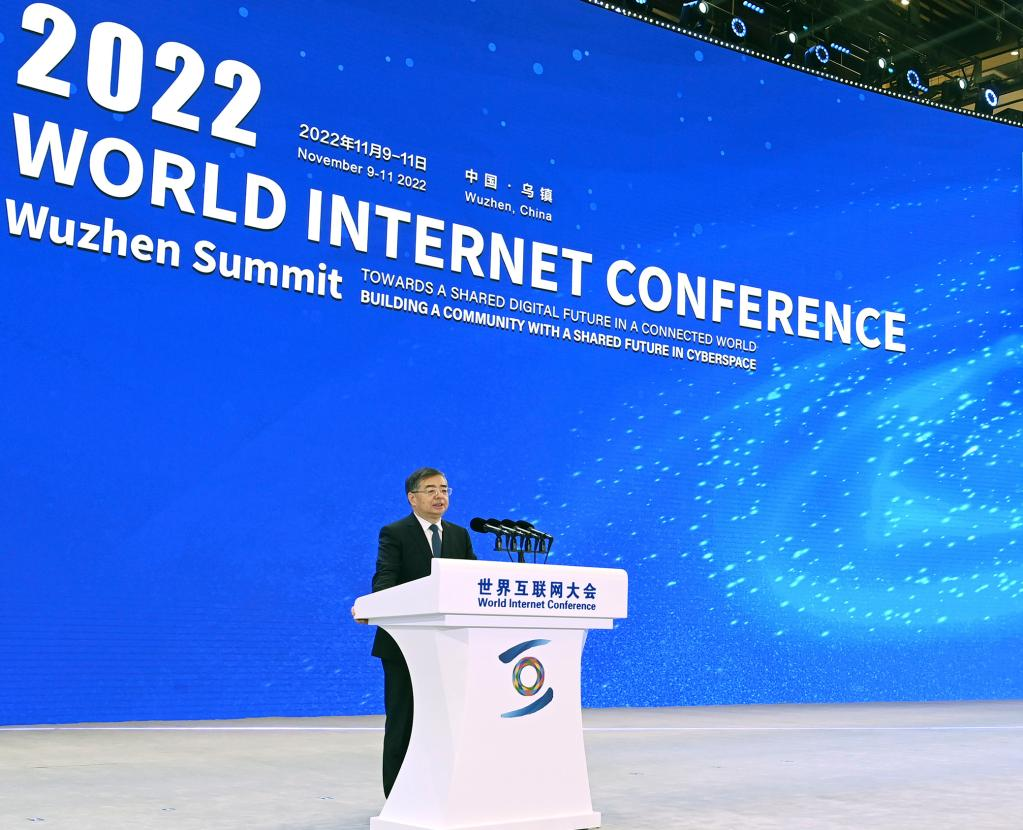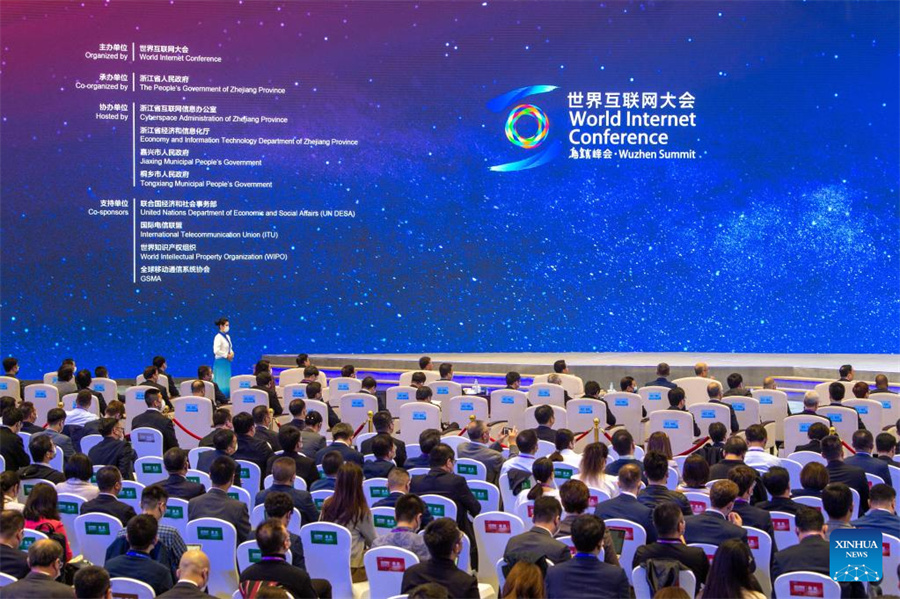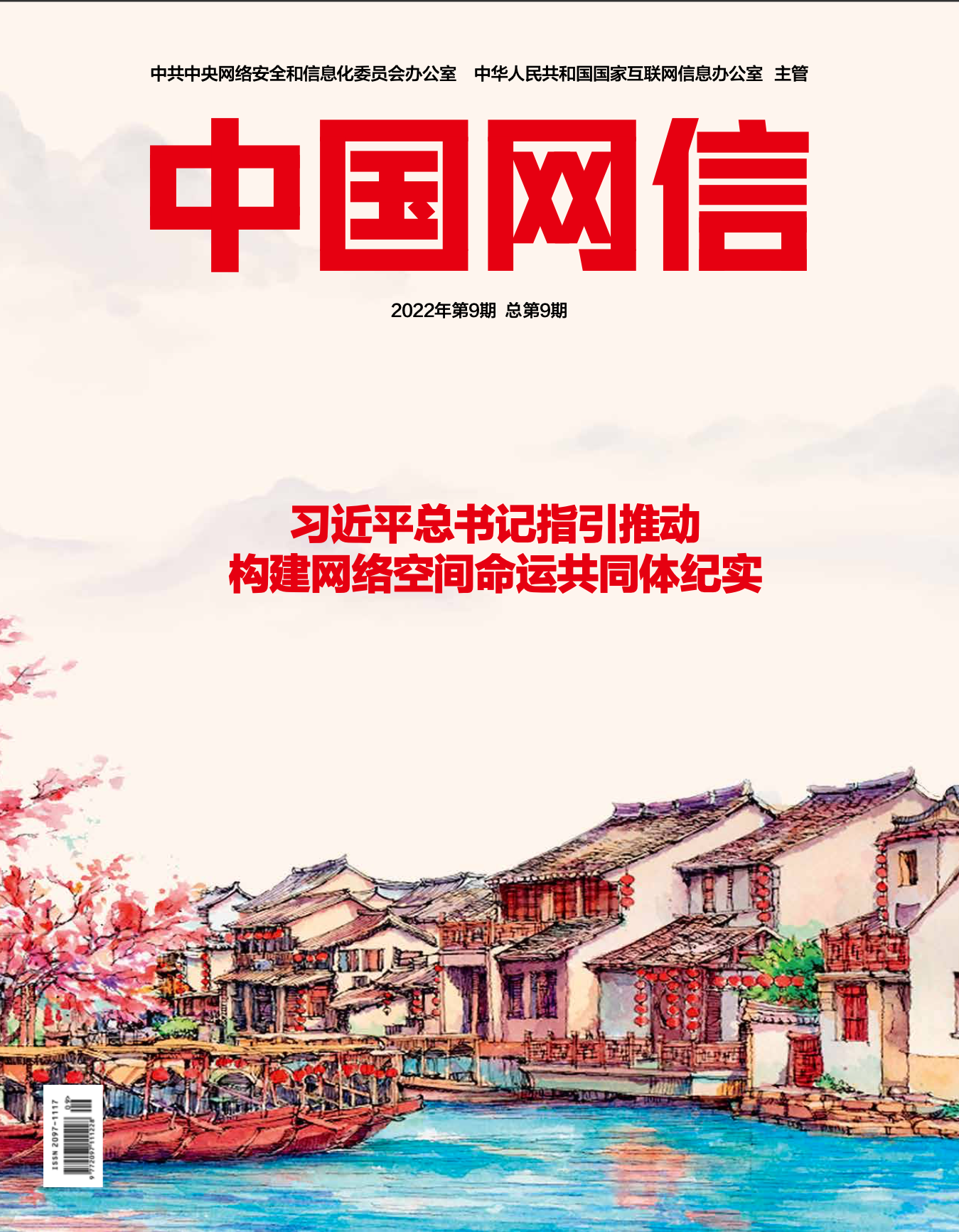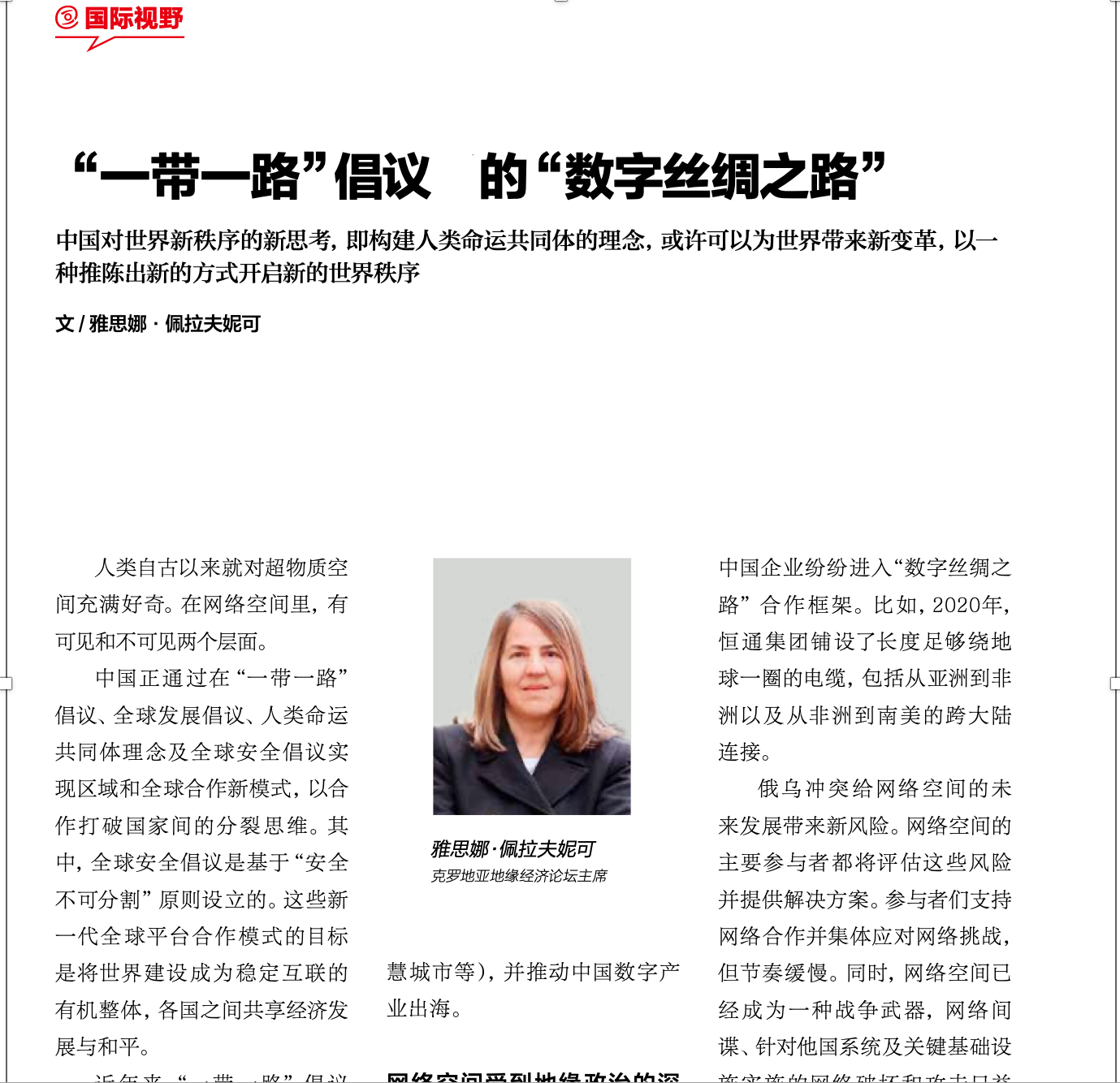Towards a Shared Digital Future in a Connected World
- Details

Li Shulei pointed out that President Xi elaborated in his congratulatory letter on the opportunities and challenges brought by digitalization to human society and expressed China's sincere desire to work with other countries to build cyberspace and embark on a promising path of global digital development.
Joining Hands to Build a Community of Shared Future in Cyberspace


On the occasion of the opening ceremony Wuzhen Summit's Journal, Issue 9, thematic focused on Joining Hands to Build a Community of Shared Future in Cyberspace, was released. The Journal presents General Secretary Xi Jinping's guidance on promoting the construction of a community with a shared future in cyberspace as a cover story.

In 2015, at the opening ceremony of the Second World Internet Conference Chinese President Xi Jinping introduced the concept of "building a community with a shared future in cyberspace" and proposed the reform of the global Internet governance system.
In the Journal no 9, the columnist are Geoff Houston, Chief Scientist, Asia Pacific Internet Network Information Center, Stephane Grumbach, French National Institute of Informatics and Automation, Eugene Kaspersky, Founder, and CEO, Kaspersky, Xu Qingqi, Chairman of Malaysia New Asia Strategic Research Center, Su Aogu, Professor of ESADE Business School in Spain, Luca Burleigh, Professor of the Faculty of Law of the Vargas Foundation, Director of the Center for Technology and Society, and Jasna Plevnik, President of the Geoeconomic Forum Croatia, who writes on the "Digital Silk Road" within the Belt and Road Initiative."
Here down pls find the text of Jasna Plevnik.

The Belt and Road Initiative's Digital Silk Road and geopolitics
The Belt and Road Initiative has its land, sea, and digital forms that are interrelated and focused on building connecting platforms for accelerating interdependence inside the physical and cyber world.
Here we discusse how the Belt and Road Initiative (BRI), and its significant part Digital Silk Road (DSR) could be influenced by current highly geostrategic competition among the global powers that struggle among themself to take global control over physical spaces of the world for assuring their economic, strategic, security and digital advantages.
The paper argues the BRI has the power to continue building physical and digital connectivity among China, Asia, Africa, and Europe regardless of strengthening the US and the European Union's geopolitical approach towards China’s global policy.
In front of the Belt and Road Initiative stands the exploration of its further development in the physical spaces and how its Digital Silk Road could answer to an outpouring of geopolitics in cyberspace.
Introduction
From ancient times people have been intrigued to transcend their physical space. In various religions, there is a belief that exists another dimension of space like Heaven but unlike cyberspace, which has visible and invisible layers, nobody knows -where is that paradise place. However, all these spaces are connected.
China is pursuing cooperation and countering the mentality of division among countries by implementing regionally and globally new models of cooperation with its four main global platforms: Belt and Road Initiative, Global Development Initiative, Community with a shared future for mankind, and the Global Security Initiative that is the newest one and based on the principle of "indivisibility of security".
The aim of these new generation models of cooperation platforms is to build the world as one stable and connected place where countries share economic development and peace.
Since 2015 the Belt and Road Initiative (BRI) has expanded from its traditional areas of connectivity into digital, forms of cooperation known as the Digital Silk Road (DSR) under which China has started to build digital connectivity (5G networks, artificial intelligence capabilities, cloud computing, e-commerce and payment systems, smart cities) among BRI’s partners and supported exports of Chinese digital industry.
All country - partners within the BRI are watching will the conflict in Ukraine affect their cooperation within the BRI and its DSR scheme that has been conceived as a digital part of the physical land-and-sea-based corridors of the Silk Road Economic Belt and the Twenty-First Century Maritime Silk Road.
Cyberspace and geopolitics
China has global domination in digital technologies like artificial intelligence and in 5G infrastructure which is an important lever in the implementation of the DSR regionally and globally.
It is ranked as the second digital economy in the world that has provided the country an advantage in cyberspace.
China's government has regulated the activities of its cyber companies, such as Huawei, JD.com, China Mobile, Alibaba, and Tencent, and included some of them within the Digital Silk Road cooperation.
Hengtong Group in 2020, laid enough cable to circle the earth, including transcontinental links from Asia to Africa and from Africa to South America.
The US, China, the European Union, and the UK support cyber cooperation and collective response to cyber challenges, but things are slowly developing in that direction and cyberspace has been used as a weapon of war, through espionage, sabotage, and attacks against systems and infrastructure of other countries.
The missiles and cyberattacks hybrid war in Ukraine has created new risks for cyberspace future development which will be evaluated and addressed by all key players in cyberspace.
In South America, some countries are considering their internet separation from the US how they could protect their computer networks by avoiding the US and its allied territories how could be less vulnerable during some future conflict.
There have been many predictions that new digital technologies would lead to a rise of cooperation in international relations at the expense of geopolitics that understands geography as space for fulfilling geostrategic interests of state and cyberspace will be de-territorialized space for global communications.
However, cyberspace has visible infrastructure (land and submarine cables, computers, and other digital equipment) and that dimension of cyberspace weakens its potential to transcend itself from political and strategic relations among states. The big powers see these visible parts of the network infrastructure as some kind of territory of other states they could control and influence.
Even before the war in Ukraine, the West has challenged China's right to digital development, and its big technology firms' right to market competition similarly as it has challenged the BRI's implementation in the global physical space.
The West ignores China's and other countries’ concerns about the U.S.'s assertiveness, and domination in cyberspace governance.
Politicisation and splintering of cyberspace
The world has changed significantly since 2015 when China launched the Digital Silk Road.
The international environment is unfolding quite contrary to cyberspace's essence — networking — under the pressure of American unipolar foreign policy, Russia's attack on Ukraine, and multiple crises of international organizations.
In that context, the DSR's role in connecting cyberspace appears to be set to grow.
The Digital Silk Road emphasises the same as the BRI - global connectivity and shared benefits so participating countries from Asia, Africa, Europe, and South America follow digital cooperation as a key strategic guideline in their cyber relations countering the trends of division.
The DSR has accelerated digital cooperation and connectivity in countries that are partners within the BRI in the digital service sector, e-commerce, finance, smart cities, computing, big data, the Internet of Things, artificial intelligence, and blockchain. Huawei has had a significant role in setting global technology standards for 5G.
China’s state provides less digital developed countries with some digital aid and funds for investment in the physical infrastructure of digital networks,
The DSR’s activities helped those people in developing countries who have limited or no access to the internet and in that way the DSR supports the BRI's people-to-people connectivity, even in countries outside the BRI framework, making the world more digitalised.
“In Africa, for instance, China already provides more financing for information and communications technology than all multilateral agencies and leading democracies combined do across the continent.”
The BRI’s activities might be one of the reasons why China is viewed more positively than the US by African youth for the first time since a survey by the South African Foundation began in 2020.
The Chinese public and private companies (Huawei, JD.com, China Mobile, Alibaba, Tencent…) are involved in constructing and integrating cyberinfrastructure - telecommunications networks, cloud services, and payments, smart cities - in Asia, Europe, Africa, and South America.
In Europe, Chines companies comply with the European Union’s technology standards and norms and Europe’s General Data Protection Regulation, as well as American companies, and do not impose its model on countries within the BRI.
The DSR’s relations are based on the market principle of supply and demand, not geopolitics, however political pressure on the BRI is on the rise in Europe and it is primarly caused by America’s pressure on Brussels.
The DSR dynamic of integration will be slower in Europe than in Asia and Africa which have become key countries within DSR’s cooperation.
If persists that situation may develop as harmful for Europe, which may lose its market attractiveness for global technology companies from China and may find itself in a situation where it will have to buy digital equipment and build new networks at much higher costs than before, which will impoverish European citizens further.
These tendencies, if continue, might have give the US power to control Europe's market moving Europe from its central role in the global economy.
China’s vison for the new world order
Most global and regional conflicts and crises come to humanity because of the superpower's inability to embrace multipolarity and transcend the power politics approach in its foreign policy. On the other hand, the transformation towards a real multipolar world order is hardly possible without the support of the USA, but they see multipolarity as a threat to their strategic and economic interests and therefore pursue policies that keep the world order in a state of unipolarism.
The West, under the leadership of Washington, is engaged in creating a new political mindset and emotion to provoke and destabilize China and the Chinese system. There are some elements of Cold War values and atmosphere in this approach, but this does not mean that the current world order has become bipolar, nor that the US goal is bipolarism in which China will play the role that the USSR played in the Cold War.
America's strategic interest is not to restore the past bipolar world order nor to continue with the current world order in which multipolarity is strengthening at the economic and technological level of the world order. The US wants to stop the development in the direction of multipolarity because it considers it dangerous for its position as a dominant power, which by the end of the 21st century aims to maintain and improve its primacy at all levels of the world order - strategic, economic, technological - although this goal of America now seems more unrealistic than before. Namely, the world has changed and there are new powers, and the reason for their emergence and influence on the state of the world is not because the USA allowed it, but because of their ability to rise economically and technologically, which, we must remind, the USA once supported with its visions and policies of building the world as one market and one place that it rejects today.
It is a mistake to think that the time of the multipolar world order has passed even though the countries that want a multipolar order are faced with new kinds of geopolitical, economic and ideological obstacles generated by the US.
Challenges to Washington's unipolar concept of world order cannot come from the US. The country has a large debt and pronounced political problems, and these facts could at one point influence the US to focus more deeply on solving its internal crisis, but it will not change its concept of the world order.
Opposition to the American theory and practice of unipolarism should come from other great powers, those who support the multipolar concept of world order and are working on it.
Before the start of the war in Ukraine, the European Union supported multipolarity and multilateralism in relations between states, but now it seems that the Union is entering the process of weakening its ability to act as an autonomous global economic power and cooperate with non-Western countries in building a multipolar international system. and acceleration of economic interdependence.
China, India, Brazil and some European and Middle Eastern countries face a historic opportunity to keep the world on the path of multipolarity and even strengthen it.
Behind China's thinking about the future of world order is the concept of a Community with a Shared Future for Humanity that has the potential to revolutionize world politics and move it forward in a non-geopolitical way.
China has set the realization of a community with a common future for mankind as a century-old project to improve relations between countries.
The concept is even more advanced and balanced compared to the multipolar world order where there can be power politics within multiple poles, while the Community sees relations between states outside of the framework of great power hegemony.
In the current conditions, the movement of the world order towards multipolarity is better for people, stability and peace in the world and more advanced than the dominance of one power.
China's important step towards building a more advanced world order began with the Belt and Road Initiative (2013), which is aimed at building a new international structure of connectivity on land and sea, and in cyberspace.
With this diplomacy, China has become the main ally of developing countries in the fight for fairer free trade and greater influence on the behavior of international financial institutions and global governance.